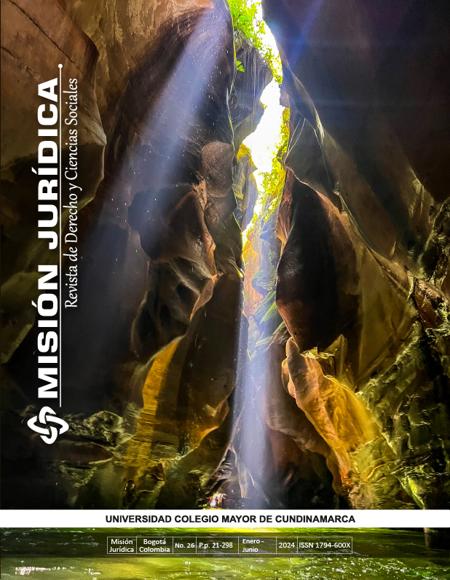Tensions Between the Judiciary and the Executive Branch in the Issuance of Unnamed Cautionary Actions Against Government Agencies: A Comparative Analysis Between Latin America and Continental Europe
La tensión entre el poder judicial y el poder ejecutivo en la emisión de medidas cautelares innominadas en contra de entidades gubernamentales: un análisis comparativo entre América Latina y Europa continental

This work is licensed under a Creative Commons Attribution-NonCommercial-NoDerivatives 4.0 International License.
COPYRIGHT PROVISIONS
Every papper included in the magazine can be reproduced whole or in part, provided that respect for its original content, the source is acknowledged and is used with non-commercial academic. Legal mission and its content is protected under a license Creative Commons Attribution-Noncommercial-

Misión Jurídica is distributed under a Creative Commons Attribution-NonCommercial-NoDerivar 4.0 International License.
Based on a work in http://unicolmayor.edu.co/publicaciones/index.php/mjuridica/index.
Permits that go beyond what is covered by this license can be found at http://unicolmayor.edu.co/publicaciones/index.php/mjuridica/index.
Show authors biography
The tension between the judicial power ('jurisdictio') and the executive power ('gubernaculum') has long been a contentious issue in the context of issuing unnamed cautionary actions against governmental agencies (Ríos Álvarez, 2015; Tridimas, 2006). This article explores the contrasting approaches to this tension in Latin America and Continental Europe, analyzing the legal and historical foundations, as well as the principles of separation of powers, judicial independence, and individual rights protection within each legal tradition (Cappelletti, 1989; Tridimas, 2006). Historically, Latin American jurisprudence tended to prioritize the protection of governmental prerogatives, hindering the imposition of temporary cautionary measures on the State (Ferrer Mac-Gregor, 2011; Courtis, 2008). Conversely, Continental Europe has seen a more robust evolution of effective judicial control over arbitrary administrative actions, including the development of innovative temporary measures (Caranta, 2018; Tridimas, 2006). Through a comparative analysis, supported by an extensive review of case law, legal frameworks, and academic literature (Guerrero, 2023; Ferrer Mac-Gregor, 2011; Courtis, 2008), this study identifies potential models from European jurisprudence that could facilitate a more balanced interaction between judicial and administrative authorities in the protection of rights in Latin America.
Article visits 5 | PDF visits 3
Downloads
- Brewer-Carías, A. R. (2011). Principios del procedimiento administrativo en América Latina. Universidad Externado de Colombia.
- Cappelletti, M. (1989). The judicial process in comparative perspective. Clarendon Press.
- Caranta, R. (2018). Interim relief in EU law: An uncharted territory. En C. Kilpatrick, T.
- Novitz, & P. Skidmore (Eds.), The future of remedies in Europe (pp. 119-146). Hart Publishing.
- Clérico, L. & Aldao, M. (2011). Tutela judicial efectiva y proceso de amparo en Argentina. Anuario Iberoamericano de Justicia Constitucional, 15, 65-98. https://doi.org/10.18042/cepc/aijc.15.03
- Comella, V. F. (2010). The constitutional construction of judicial power. Routledge.
- Comisión Interamericana de Derechos Humanos. (2013). Garantías para la independencia de las operadoras judiciales. OEA.
- Courtis, C. (2008). Criterios de vigencia y realidad aplicativa de los derechos humanos en América Latina. En E. Ferrer Mac-Gregor & A. Herrera García (Eds.), La garantía jurisdiccional de los derechos humanos: un enfoque desde el derecho comparado (pp. 3-24). Porrúa.
- Ferrer Mac-Gregor, E. (2011). Panorámica del derecho procesal constitucional y convencional. Marcial Pons.
- Gil, C. A. (2019). La tensión entre jurisdicción y gubernaculum en la acción de tutela colombiana. Revista de Derecho Público, 42, 1-28. https://doi.org/10.15425/redepub.42.2019.03
- Guerrero, F. (2023). Comparativa de las Medidas Cautelares Innombradas en el Proceso Laboral: Un análisis entre Colombia, Argentina, Brasil y Chile. Ciencia Latina Revista Científica Multidisciplinar, 7(5), 6948-6962. https://doi.org/10.37811/cl_rcm.v7i5.8277
- Nelken, D. (2010). Towards a sociological conception of legal transplants. En D. Nelken & J. Feest (Eds.), Adapting legal cultures (pp. 39-53). Hart Publishing.
- Ríos Álvarez, L. (2015). La separación de poderes en la historia constitucional de América Latina. Fondo de Cultura Económica.
- Sieder, R., Schjolden, L., & Angell, A. (Eds.). (2005). The judicialization of politics in Latin America. Palgrave Macmillan.
- Tridimas, T. (2006). The general principles of EU law (2.ª ed.). Oxford University Press.
- Waldron, J. (2016). The rule of law and the measure of property. Cambridge University Press.
- Casos C-213/89, C-221/89 y C-465/93, Factortame y otros (1990).
- Sentencia T-786 (2003), Corte Constitucional de Colombia.
- Sentencia T-1031 (2001), Corte Constitucional de Colombia.
- Ley 29/1998, de 13 de julio, reguladora de la Jurisdicción Contencioso-Administrativa, España. Boletín Oficial del Estado, 167, 14/07/1998. https://www.boe.es/buscar/act.php?id=BOE-A-1998-16718















